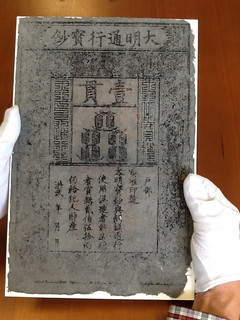
PREV ARTICLE
NEXT ARTICLE
FULL ISSUE
PREV FULL ISSUE
MING DYNASTY NOTES: OLD, BUT NOT RARE
David Hill of the American Numismatic Society published a great piece on the ANS Pocket Change blog about the world's oldest
surviving paper money, the Ming dynasty notes from China. -Editor
The Met passed Ehrenfeld’s letter on to the ANS, which left curator Howland Wood to deliver the bad news. His father’s note was not worth fifty thousand dollars. It was worth five dollars. Wood knew this because he had sold fourteen of them himself for that price. There were many others in New York alone, Wood told him, including several in the collections of the ANS. The problem for Mr. Ehrenfeld, as Wood explained, was that his treasured item was not as rare as it once had been. In 1900, some European soldiers, who had been sent to China to restore peace during the Boxer Rebellion but who were instead ransacking the imperial Summer Palace, discovered a large quantity of these notes under an overturned statue of Buddha. (An entire bale of one kwan Ming dynasty notes would be discovered in 1936, hidden in an old wall outside of Beijing.) Ehrenfeld was right about one thing. Well, almost: with very few exceptions, these are the oldest examples of paper money known to have survived. The Chinese not only invented paper, they invented paper money during the reign of emperor Chen Tsung (998-1022 AD). Examples predating the Ming notes are rarely encountered and are limited to fragments, modern facsimiles made from brass plates recovered in excavations, and a few notes reportedly held in museums. In 1988, Bank Note Reporter announced the discovery of two notes dating from 1265, one at the Hermitage Museum in Saint Petersburg and the other illustrated in a book published by the Inner Mongolia Numismatic Research Institute. These notes date from the period just before the arrival of Marco Polo at the court of the Mongol emperor Kublai Khan. To read the complete article, see:

Wayne Homren, Editor The Numismatic Bibliomania Society is a non-profit organization promoting numismatic literature. See our web site at coinbooks.org. To submit items for publication in The E-Sylum, write to the Editor at this address: whomren@gmail.com To subscribe go to: https://my.binhost.com/lists/listinfo/esylum All Rights Reserved. NBS Home Page Contact the NBS webmaster 
|
